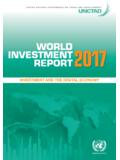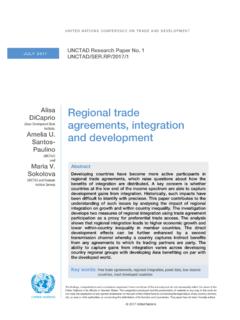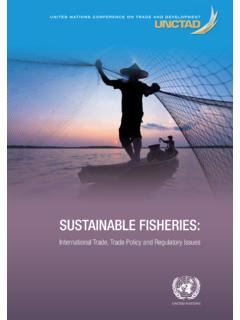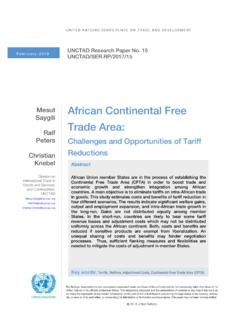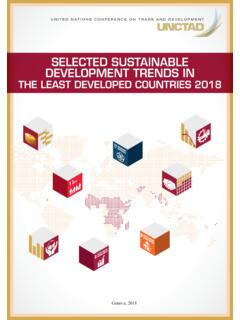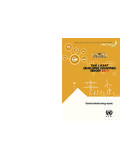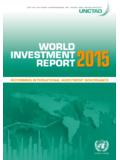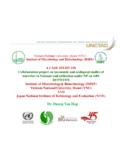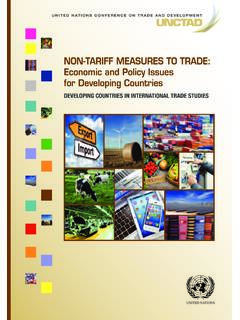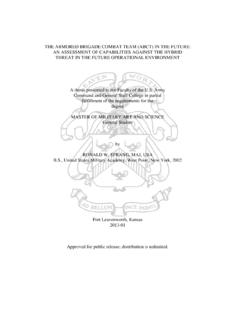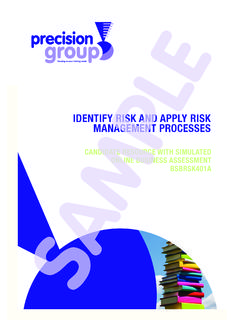Transcription of How to Prepare Your Business Plan - UNCTAD | Home
1 UNITED NATIONS CONFERENCE ON TRADE AND DEVELOPMENT How to Prepare your Business plan UNITED NATIONS New York and Geneva, 2002 ii Note UNCTAD serves as the focal point within the United Nations Secretariat for all matters related to foreign direct investment and transnational corporations. In the past, the Programme on Transnational Corporations was carried out by the United Nations Centre on Transnational Corporations (1975-1992) and the Transnational Corporations and Management Division of the United Nations Department of Economic and Social Development. UNCTAD seeks to create an enabling environment for international investment and enterprise development. Its work is carried out through intergovernmental deliberations, technical assistance activities, seminars, workshops and conferences. The term country as used in this study also refers, as appropriate, to territories or areas; the designations employed and the presentation of the material do not imply the expression of any opinion whatsoever on the part of the Secretariat of the United Nations concerning the legal status of any country, territory, city or area or of its authorities, or concerning the delimitation of its frontiers or boundaries.
2 In addition, the designations of country groups are intended solely for statistical or analytical convenience and do not necessarily express a judgement about the stage of development reached by a particular country or area in the development process. The reference to a company and its activities should not be construed as endorsement or acceptance by UNCTAD of the company or its activities. The following symbols have been used in the tables: Two dots (..) indicate that data are not available or are not separately reported. Rows in tables have been omitted in those cases where no data are available for any of the elements in the row; A hyphen (-) indicates that the item is zero or its value is negligible; iiiA blank in a table indicates that the item is not applicable, unless otherwise indicated; A slash (/) between dates representing years, 1994/1995, indicates a financial year; The use of a dash (-) between dates representing years, 1994-1995, signifies the full period involved, including the beginning and end years; Reference to dollars means United States dollars, unless otherwise indicated; Annual rates of growth or change, unless otherwise stated, refer to annual compound rates; Details and percentages in tables do not necessarily add to totals because of rounding.
3 The material contained in this study may be freely quoted with appropriate acknowledgement. UNCTAD /ITE/11A/5 Copyright United Nations, 2002 All rights reserved Manufactured in Switzerland iv Preface This publication was prepared in the framework of a technical assistance project aimed at strengthening the capacity of least developed countries to mobilize resources through venture capital funds. It is intended for use in the training of senior and middle management in Business planning and as a reference manual for individual enterprises to Prepare their Business plans, for submission to investors for funding, including venture capital funds. The manual is applicable to many types of businesses, including start-ups; on going or expanding businesses; production or service firms in any sector; small, medium or large corporations; sole proprietorships; partnerships; joint-stock companies; and locally, nationally or internationally active companies.
4 It is thus unavoidable that the manual gives almost a maximum list of items for inclusion in a Business plan . Companies can pick and choose among the items discussed, according to their specific situations and needs. Under the overall direction of Karl P. Sauvant and Anh-Nga Tran-Nguyen, this manual was prepared by George Malcotsis, in collaboration with Reinhard Behrens, Rene Gerber, Janos Fazekas, Dietmar Kuck, Andreas Ragaz and Lukas Sch rer. It has benefited from comments by Petri Koivula as well as by participants by in several training workshops to discuss Business plans, organized in Ukraine in 2001. UNCTAD is grateful to the Government of Norway, which financed the technical assistance within the framework of which this manual was prepared. Rubens Ricupero Geneva, January 2002 Secretary-General of UNCTAD v Contents Page iv PART ONE: INTRODUCTION CHAPTER I: THE ABC OF A Business A.
5 What is a Business plan ?..2 B. Why a Business plan ?..2 C. Who reads the Business plan ?..3 D. How to Prepare a Business plan ?.. 6 1. Who prepares a Business plan ?..6 2. What are the steps in the planning process?.. 7 a. Assessing the b. Developing a c. Getting 10 d. Setting 11 e. Working out the Business 11 f. Setting employee 12 g. Monitoring the 12 E. What is expected from the investor/lender?..13 F. Different types of Business 13 G. Format and organization of a Business 17 H. Planning 19 I. Content and structure of a Business 23 PART TWO: BASIC ELEMENTS OF A Business plan CHAPTER II: EXECUTIVE 29 A. Purpose of the Business 30 viB. Main 31 C. Financial 32 D. Example of an executive 33 CHAPTER III: 36 A. Main products, markets and 36 B. Location and 37 C. Key 38 D. Legal form, ownership and 38 E. Historical development and track record of the 39 F. Business strategy and 40 G.
6 General organization/operating 40 CHAPTER IV: PRODUCTS AND 42 A. Product description and 42 B. Product 43 C. Research and 46 D. Product life 46 E. Costing and 48 1. 48 2. 50 a. Buyer's 50 b. Seller's point of 52 F. Production 55 G. Quality assurance and 57 H. 58 I. Intellectual 58 CHAPTER V: MARKETS, CLIENTS AND 60 A. Introductory 60 B. Market 61 C. 62 D. 62 E. 63 F. Market 65 G. Projected 69 vii CHAPTER VI: Business OPERATIONS AND 70 A. Location and 70 1. 70 2. 73 B. 74 1. General 74 2. Promotion and 75 C. Selling 76 D. 78 E. 79 F. Order processing and inventory 81 G. Company 82 H. Project 84 I. Management information 86 CHAPTER VII: HUMAN 88 A. 88 1. 89 2. Board of 89 3. Executive 90 4. Middle 92 5. External support 94 B. 94 C. Practical issues venture capitalists will 95 1.
7 Technical skills and competencies of 96 2. Attitudes and human characteristics of 100 3. Team 104 4. Values and norms of the 104 CHAPTER VIII: LEGAL FRAMEWORK, AND ENVIRONMENTAL AND SOCIAL 106 A. Approvals and licensing 106 B. Social compliance 107 C. Development and social 109 viiiD. Environmental 110 1. The concerns of 2. The concerns of 111 3. Examples of questions lenders and investors may 112 CHAPTER IX: FINANCIAL 117 A. Introductory 117 B. Financial 119 C. Income statement 120 D. Cash flow 122 1. What is cash 122 2. Why do you need cash flow planning?.. 127 3. How to Prepare a cash flow 129 a. Steps in preparing your cash flow 129 b. Designing a cash flow 131 c. Tools for cash flow 132 4. Some more hints for preparing/improving your cash 132 E. Balance sheet 135 F. Important financial 139 1. Liquidity 140 a. Current ratio .. 141 b.
8 Quick test ratio .. 142 2. Efficiency ratios .. 143 a. Inventory turnover .. 144 b. Accounts receivable turnover .. 145 c. Accounts payable turnover .. 146 d. Fixed assets turnover .. 147 e. Total assets turnover .. 148 3. Profitability ratios .. 148 a. Gross profit margin .. 149 b. Net profit margin .. 150 c. Operating profit margin .. 151 d. Return on assets .. 152 e. Return on equity .. 153 f. Dividend payout .. 154 4. Solvency ratios .. 155 a. Debt to equity ratio .. 155 ixb. Total assets to equity ratio .. 156 c. Total assets to total liabilities ratio .. 157 d. Capitalization ratio .. 158 e. Interest coverage ratio .. 159 G. Methods for ranking investment 160 1. Payback period .. 160 2. Net present value .. 161 3. Internal rate of return .. 163 H. Request for funds and other supporting 164 1. Request for 164 2. Risk assessment .. 165 3. Start-up Business financial information.
9 167 I. Numerical 168 PART THREE: CONTINGENCY PLANS CHAPTER X: RISK AND SENSITIVITY 178 A. Introductory 178 B. Types of 179 1. General economic 179 2. 180 3. Changes in public 182 4. 183 5. Law 183 6. 184 7. 185 8. Quality/production 185 9. 10. 187 C. Managing 187 D. SWOT 188 192 xBoxes Where did the habit of five-year planning originate?.. 21 Example: fish 55 Example: executive 56 Making a good 100 Regulatory 182 Figures Role of the employees in the Business planning 12 Example: Legal shareholding structure of SBTP 39 Accumulated income during the life cycle of a 47 Chain of product 48 The method for setting the price of your 54 Typical organization chart of a production Example of a project plan : construction of a plant for production of mango 85 Determination of 163 Tables Comparison of different pricing 53 Analysis of competitive 66 Analysis of market 66 Position in the 67 Matrix of 68 The basic characteristics of 96 Characteristics for 100 Income 122 Sources and uses of cash 126 Example.
10 Reconciling cash revenues and 131 Cash flow 134 Balance 138 Current 141 Quick test 142 Inventory 144 Accounts receivable 145 Accounts payable 146 Fixed assets 147 Total assets Gross profit 149 Net profit 150 Operating profit 151 Return on 152 Return on 153 Dividend 154 Debt to equity 155 Total assets to equity 156 Total assets to total liabilities 157 Capitalization 158 Interest coverage 159 Income statement: an 171 Balance sheet: an 172 Cash flow statement: an 173 Investment and depreciation plan : an 174 Reconciliation of shareholder's 174 Calculation of provisions for tax: an 175 Financing plan : an 175 Ratio summary 176 Examples of 183 Strengths and 189 Opportunities and 190 PART ONE INTRODUCTION UNCTAD , How to Prepare your Business plan 3 CHAPTER I THE ABCs OF A Business plan A.
